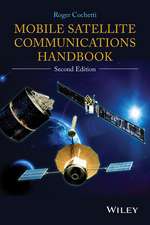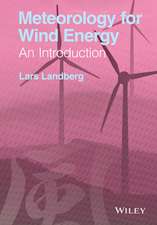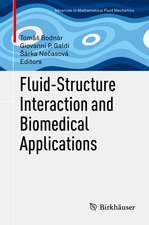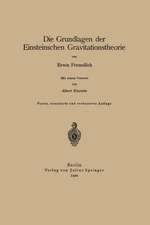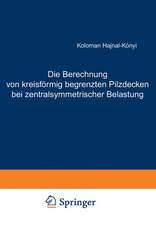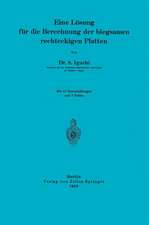Elements of Continuum Mechanics and Conservation Laws
Autor S.K. Godunov, Evgenii I. Romenskiien Limba Engleză Hardback – 30 mai 2003
The theory presented in this book stems from research carried out by the authors concerning the formulations of differential equations describing explosive deformations of metals. In such processes, elasticity equations are used in some zones, whereas hydrodynamics equations are stated in other zones. Plastic deformations appear in transition zones, which leads to residual stresses. The suggested model contains some relaxation terms which simulate these plastic deformations. Certain laws of thermodynamics are used in order to describe and study differential equations simulating the physical processes. This leads to the special formulation of differential equations using generalized thermodynamical potentials.
| Toate formatele și edițiile | Preț | Express |
|---|---|---|
| Paperback (1) | 985.68 lei 6-8 săpt. | |
| Springer Us – 30 noi 2010 | 985.68 lei 6-8 săpt. | |
| Hardback (1) | 992.26 lei 6-8 săpt. | |
| Springer Us – 30 mai 2003 | 992.26 lei 6-8 săpt. |
Preț: 992.26 lei
Preț vechi: 1240.32 lei
-20% Nou
Puncte Express: 1488
Preț estimativ în valută:
189.89€ • 197.05$ • 158.72£
189.89€ • 197.05$ • 158.72£
Carte tipărită la comandă
Livrare economică 18 martie-01 aprilie
Preluare comenzi: 021 569.72.76
Specificații
ISBN-13: 9780306477355
ISBN-10: 0306477351
Pagini: 258
Ilustrații: VIII, 258 p.
Dimensiuni: 155 x 235 x 18 mm
Greutate: 0.56 kg
Ediția:2003
Editura: Springer Us
Colecția Springer
Locul publicării:New York, NY, United States
ISBN-10: 0306477351
Pagini: 258
Ilustrații: VIII, 258 p.
Dimensiuni: 155 x 235 x 18 mm
Greutate: 0.56 kg
Ediția:2003
Editura: Springer Us
Colecția Springer
Locul publicării:New York, NY, United States
Public țintă
ResearchDescriere
Elements of Continuum Mechanics and Conservation Laws presents a systematization of different models in mathematical physics, a study of the structure of conservation laws, thermodynamical identities, and connection with criteria for well-posedness of the corresponding mathematical problems.
The theory presented in this book stems from research carried out by the authors concerning the formulations of differential equations describing explosive deformations of metals. In such processes, elasticity equations are used in some zones, whereas hydrodynamics equations are stated in other zones. Plastic deformations appear in transition zones, which leads to residual stresses. The suggested model contains some relaxation terms which simulate these plastic deformations. Certain laws of thermodynamics are used in order to describe and study differential equations simulating the physical processes. This leads to the special formulation of differential equations using generalized thermodynamical potentials. The structure of conservation laws and new ideas and methods of constructing mathematical models are presented.
The final chapter: Structure of Thermodynamically Compatible Systems reflects Godunov's latest research. It presents an approach to the formalization of equations of continuum mechanics, in particular, relationships between the structure of thermodynamical conservation laws and representations of the rotation group. The material covered in this chapter was written during the preparation of the English edition and intensively discussed with specialists in different countries and presented at lectures given by Godunov in 2002.
This book describes the theory developed by Godunov together with his former student Evgenii Romenskii which presents a systematization of different models of elastic media and related classification of hyperbolic equations.
The theory presented in this book stems from research carried out by the authors concerning the formulations of differential equations describing explosive deformations of metals. In such processes, elasticity equations are used in some zones, whereas hydrodynamics equations are stated in other zones. Plastic deformations appear in transition zones, which leads to residual stresses. The suggested model contains some relaxation terms which simulate these plastic deformations. Certain laws of thermodynamics are used in order to describe and study differential equations simulating the physical processes. This leads to the special formulation of differential equations using generalized thermodynamical potentials. The structure of conservation laws and new ideas and methods of constructing mathematical models are presented.
The final chapter: Structure of Thermodynamically Compatible Systems reflects Godunov's latest research. It presents an approach to the formalization of equations of continuum mechanics, in particular, relationships between the structure of thermodynamical conservation laws and representations of the rotation group. The material covered in this chapter was written during the preparation of the English edition and intensively discussed with specialists in different countries and presented at lectures given by Godunov in 2002.
This book describes the theory developed by Godunov together with his former student Evgenii Romenskii which presents a systematization of different models of elastic media and related classification of hyperbolic equations.
Cuprins
I: Elementary Properties of Deformations and Stresses. Deformations and Strain. General Properties of Stresses. Stressed State at a Point. Isotropic Elastic Medium, Equation of State, and the Murnaghan Formulas. Viscous Stresses in an Isotropic Medium. Strain Tensors and Distortion Tensor. Murnaghan Formulas in the Tensor Form and Small Deformations. Moving Medium. Murnaghan Formulas. II: Effective Elastic Deformation. Relaxation of Stresses. Equations for the Metric Effective Elastic Deformation Tensor. Compatibility Conditions. Description of Relaxation of Shear Stresses by Equations for Effective Distortion. Defects of Crystal Lattice. Review of Notions. Dislocations. III: Differential Equations of Dynamical Processes. Conservation Laws. Consequences of Conservation Laws. Deformation of a Layer and a Bar. Equations for One-Dimensional Nonstationary Processes and Structure of Stationary Waves in a Maxwell Medium. IV: Well Posedness of Differential Equations and Thermodynamics. Well Posedness Conditions for Equations of Elasticity. Equations of Linear Elasticity as Symmetric Hyperbolic Equations. Symmetrization of Equations of Gas Dynamics. Influence of Small Viscosity on the Behavior of Solutions. Well Posedness Stability and Postulates of Phenomenological Thermodynamics. V: Multi-Dimensional Thermodynamically Compatible Conservation Laws. Gas Dynamics Equations and Magnetic Hydrodynamics Equations. Equations of Elasticity. Structure of Multi Dimensional Equations. Symmetric Hyperbolicity in the Three-Dimensional Case. Appendix: Structure of Thermodynamically Compatible Systems; S.K. Godunov. Mathematical Aspects. The Simplest Galilei-Invariant Thermodynamically Compatible Systems. Methods of Constructing Equations. Some Facts of the Theory of Representations of Orthogonal Transformations. The Clebsch-Gordan Coefficients. Orthogonal Invariants. Literature. Subject Index.
Recenzii
From the reviews:
"The authors present a systematic investigation of a variety of models in mathematical physics. … The theory presented here stems from some very beautiful results obtained by the authors concerning the formulation of differential equations describing explosive deformations of metals." (Konstantina Trivisa, Mathematical Reviews, 2005 e)
"The authors present a systematic investigation of a variety of models in mathematical physics. … The theory presented here stems from some very beautiful results obtained by the authors concerning the formulation of differential equations describing explosive deformations of metals." (Konstantina Trivisa, Mathematical Reviews, 2005 e)



